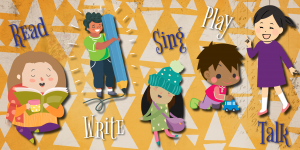
Children birth to age five can have a lot of feelings, but they don’t always know how to express these feelings in words. Social emotional learning helps children to understand and manage their emotions, while improving relationships with adults and peers. Activities that build a child’s social emotional vocabulary help kids to better understand and express their emotions with words. Connecting feelings and experiences to concrete vocabulary words helps children to develop more self-awareness and to build better relationships with others.
Reading with your child is a great way to build their social emotional vocabulary. Here are some suggestions for reading together in a way that fosters social emotional growth:
 Babies
Babies
- Hold or cuddle babies while reading to them. Touch is important to babies; it helps them to feel safe and loved. Babies are more receptive to learning new things when they are in a safe and warm environment.
- Show your baby books with pictures of faces. Expose them to a range of emotions in pictures. Babies love to look at the faces of other people, and this practice familiarizes them with what different emotions look like on different faces.
Toddlers
- Establish a reading routine with your toddler. Creating routines or schedules with young children helps them to feel safe and secure, which creates an environment perfect for learning.
- Read and talk about feelings in your home language. It is important for children to see the language spoken in their own home when they read stories. Developing a good understanding of vocabulary words in their first language will provide them a good foundation to discuss their emotions and relationships in both English and their native language.
 Preschoolers
Preschoolers
- Ask children how the events or characters in a story make them feel. This practice will help them identify their feelings and connect them with vocabulary words.
- Help your children identify how characters in a story may be feeling. Look at facial expressions in illustrated books. You can make statements about a character’s feelings, such as, “Wow, Maria is crying. She must be sad that she can’t eat any of the pie.”
-Mandy, Library Associate, Martha Cooper Library
 Read, Write, Talk, Sing, Play!
Read, Write, Talk, Sing, Play!
Reading helps children understand how text works and positions them to increase their language and literacy skills throughout their lives.
Read more about early literacy and how you can make a difference in your child's life.

